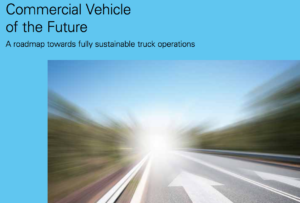The International Road transport Union (IRU) published a report on the commercial vehicle of the future based on three scenario’s (short term, mid term, long term), in terms of improvements in CO2 emissions, safety and operational efficiency. The report presents a roadmap towards fully sustainable truck operations for long haul, regional delivery, and urban delivery.
The report’s aim is to take stock of how evolving technologies and trends could shape the use of commercial vehicles in the future, how they might help the transport sector meet the EU’s ambitious CO2 emissions reduction goals for 2050 and how these measures might have positive cross-over benefits for improving road safety and operational efficiency.
Measures
A wide variety of measures is examined which could contribute to reducing emissions and further increasing road safety and operational efficiency. The list is non-exhaustive because the development of some measures, such as hydrogen fuel cell technology, is not advanced enough to give an accurate picture of their potential contribution.
However, for urban deliveries the report does not look at the opportunities of light electric freight vehicles and cargo bikes. That’s a opportunity missed…
Propulsion
These measures include a number of propulsion systems and energy carriers, such as further technological improvements to internal combustion engines (ICEs) running on diesel, the use of natural, bio- and synthetic gas or advanced biofuels and different technologies for electrification. Other vehicle-related aspects are also examined including aerodynamics, tyres and light-weighting.
Vehicle driving
Vehicle driving, including the use of Advanced Driver Assistance Systems, driver training and awareness raising are examined.
ITS
The impact of a greater use of Intelligent Transport Systems is considered, as are increased connectivity between vehicles and between vehicles and infrastructure. That enhanced connectivity should enable a Europe-wide roll-out of truck platooning technology and its potential evolution towards the use of fully autonomous vehicles.
Logistics concepts
The contribution of changes in the organisation of logistics and supply chains is also considered, including the potential impact of further digitalisation, the emergence of practices linked to the sharing economy and changes in the rules on the weights and dimensions of road freight transport vehicles.
The report is a good read for everybody involved with strategy development in transport and distribution; managers and policy makers. You can download it here.
TML in Leuven (B) assisted the International Road transport Union in discovering the features of the commercial vehicle of the future.
Source: TML

